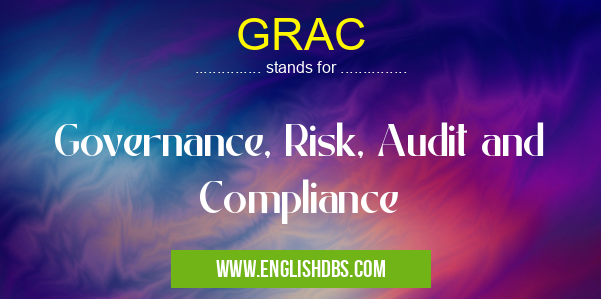What does GRAC mean in AUDITING
Governance, Risk, Audit and Compliance (GRAC) is a comprehensive approach to managing organizational risk and ensuring corporate compliance with applicable laws and regulations. GRAC provides organizations with an effective way to monitor their operations, identify areas of potential risk, and take proactive action to mitigate those risks. It also assists organizations in implementing procedures that ensure ongoing compliance.

GRAC meaning in Auditing in Business
GRAC mostly used in an acronym Auditing in Category Business that means Governance, Risk, Audit and Compliance
Shorthand: GRAC,
Full Form: Governance, Risk, Audit and Compliance
For more information of "Governance, Risk, Audit and Compliance", see the section below.
What is Governance?
Governance refers to the structures and processes that are put into place so that the organization can proactively manage its operations for the benefit of all stakeholders. Good governance helps ensure consistent decision-making, accountability, transparency, and fairness when it comes to making decisions about how resources are allocated and managed within the organization. This includes things like setting up committees or boards of directors who oversee day-to-day operations as well as developing policies and procedures that guide how things should be done.
What is Risk?
Risk management is a critical component of GRAC because it helps identify potential threats to an organization's financial health or reputation. Risk management involves understanding the sources of risk within an organization, assessing their impact on the organization's objectives, evaluating possible countermeasures, implementing measures to reduce or eliminate identified risks, monitoring them using internal controls or other systems such as audit programs, reporting any changes in risk levels over time, and responding quickly when something unexpected occurs.
What is Audit?
An audit is an independent review of an organization's financial records or operating practices to verify accuracy, completeness and compliance with applicable standards. Audits provide assurance that financial reports are being prepared accurately in accordance with accepted accounting principles or regulatory requirements such as Generally Accepted Accounting Principles (GAAP) or Sarbanes Oxley (SOX). An audit can also be used to assess whether internal controls are functioning properly and whether policies are being followed.
What is Compliance?
Compliance refers to adherence with laws and regulations that govern a particular business activity. Organizations must comply with relevant local laws as well as industry-specific regulations such as HIPAA for healthcare providers or PCI DSS for payment processors. Organizations have a duty to establish a framework for ensuring ongoing compliance through detailed policies and procedures for each area where regulations apply.
Essential Questions and Answers on Governance, Risk, Audit and Compliance in "BUSINESS»AUDITING"
What is Governance, Risk, Audit and Compliance (GRAC)?
GRAC stands for Governance, Risk, Audit and Compliance. This is a collection of processes aimed at ensuring the organization meets its objectives in an ethical manner while mitigating potential risks to the business. It involves establishing policies and procedures that are necessary to adhere to applicable laws and regulations, managing risk effectively, auditing and reviewing activities regularly, and adhering to industry standards of compliance.
How does governance influence GRAC?
Governance plays an integral role in GRAC by implementing clear direction from senior management on how the organization should operate. This ensures that risks are managed appropriately, activities are monitored closely and any non-compliance is identified and corrected quickly. Effective governance can help ensure the organization achieves its desired goals without incurring unnecessary risks or losses.
What types of risk does GRAC involve?
GRAC involves assessing a variety of types of risk including financial risk, operational risk, compliance risk, reputational risk, legal risk etc. It also includes assessing potential vulnerabilities in order to mitigate them before they become problematic.
What role does audit play in GRAC?
Auditing plays a crucial role in GRAC as it helps identify areas where there may be non-compliance with internal policies or external regulations so that corrective actions can be taken quickly. Regular audits also ensure that risks are being managed effectively and that only legitimate transactions take place within the organization.
Why is compliance important for organizations?
Compliance is important for organizations because it helps ensure that they meet their obligations under applicable laws and regulations. It also reduces the potential for costly fines or penalties if non-compliance were to occur which could have serious consequences on an organization's reputation or bottom line.
How often should an organization review its GRAC policies?
Organizational policies related to GRAC should be reviewed regularly (e.g., annually) in order to make sure they are up-to-date with changes in regulations or technology as well as any lessons learned based on previous audits and reviews.
What data should organizations collect in order to assess their risks?
Organizations should collect data about their operations such as number of employees, key customers, vendors/suppliers etc., financial information such as revenues/expenses/taxes paid etc., customer data such as demographics/usage trends etc., vendor or supplier data such as performance metrics etc., regulatory requirements applicable to their business etc.
Final Words:
GRAC helps organizations anticipate problems before they occur by establishing comprehensive strategies for managing organizational risk while remaining compliant with applicable laws and regulations. By adopting these best practices, organizations will be better able to protect their assets while achieving greater operational efficiency.
